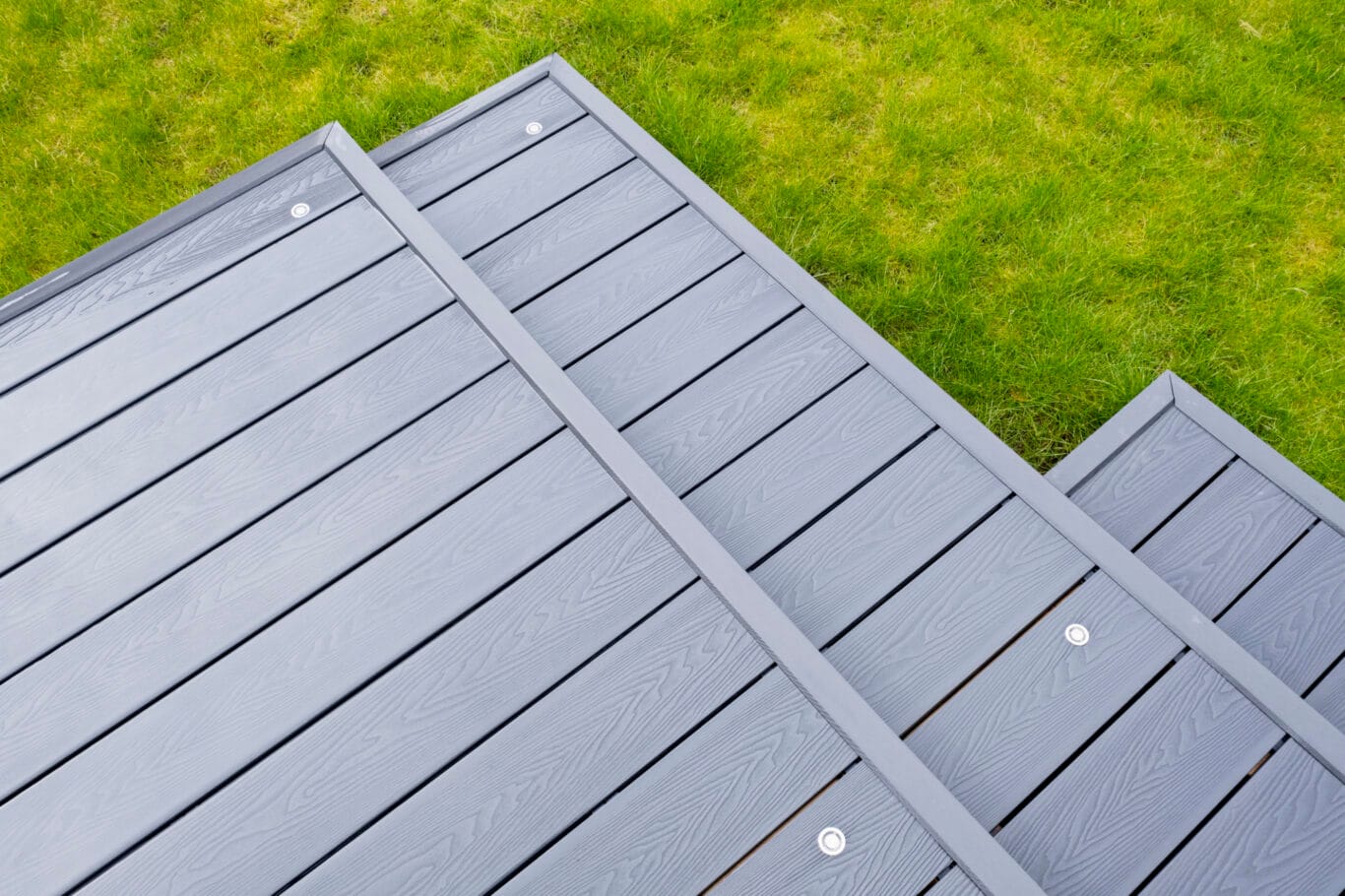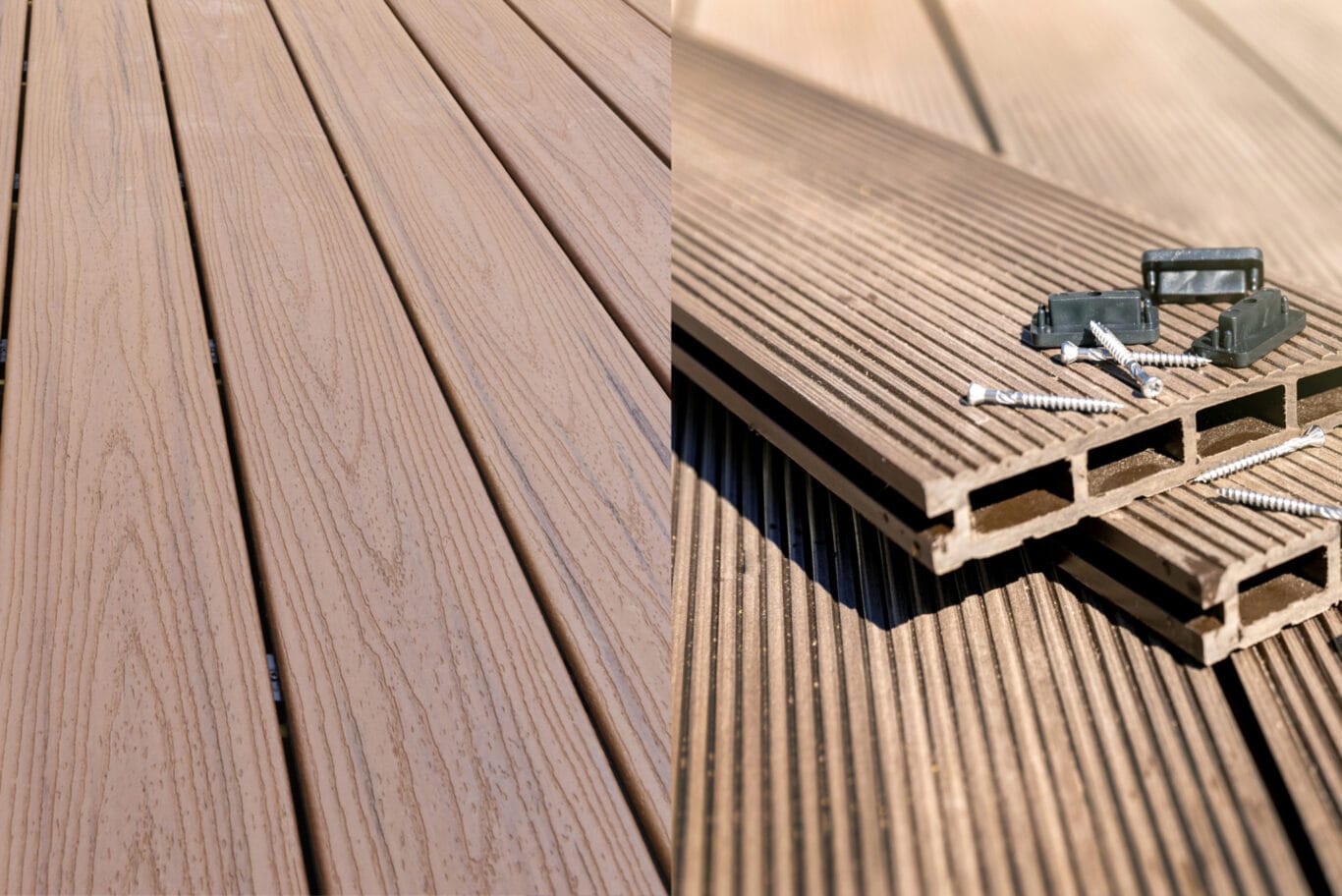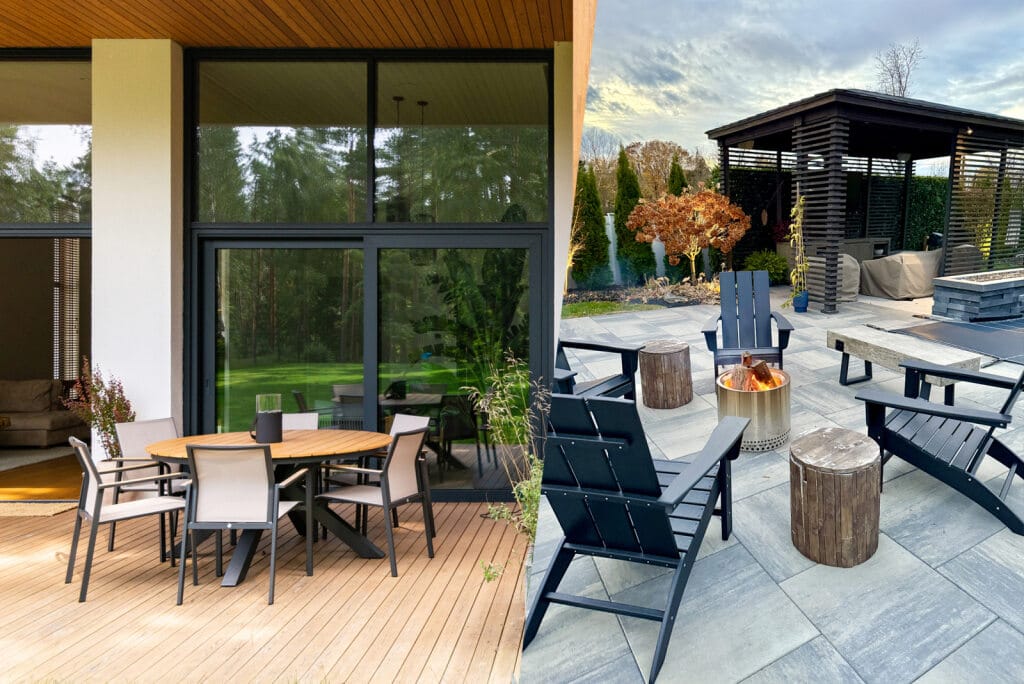Table of Contents
Choosing the right decking material is the foundation of creating your dream outdoor space. With so many deck material options available—from the timeless charm of wood decking to the sleek durability of composite decking—finding the perfect fit can feel overwhelming. Each material has pros and cons, impacting not just the look of your deck but also its longevity, maintenance needs, and cost.
In this guide, we’ll compare the most popular decking materials, explore their unique benefits, and help you make an informed choice. Whether you envision a cozy paving stone patio, a natural cedar deck, or a modern composite deck, we’ll help you weigh your options and find the ideal match for your budget, lifestyle, and outdoor vision.
What’s Better, a Wood Deck or a Paving Stone Patio?
You may hesitate between a wood deck and a paving stone patio when designing your outdoor space. Both are excellent deck material options but offer distinct advantages depending on your needs and preferences.
A wood deck provides natural warmth, charm, and a seamless connection with nature. Commonly made from pressure-treated wood, cedar, or redwood, wooden decks are versatile and can be elevated or built at ground level, making them ideal for uneven terrain. However, wood decks require regular care, such as sealing or staining, to protect against weathering.
On the other hand, a paving stone patio delivers longevity, minimal upkeep, and a sleek, modern appearance. Ideal for ground-level spaces, patios made from paving stones, concrete, or tiles create a stable patio floor that resists moisture and insects. Paving stone patios require less upkeep than wood decks, though they may need occasional resealing to prevent cracks.
Both options can enhance your outside patio, but your choice depends on style, budget, and intended use. A wood deck may be the perfect choice if you prefer a natural, elevated look and don’t mind regular upkeep. A paving stone patio could be your best bet for a more durable, low-maintenance solution.
What Are Some Weather-Resistant Deck Materials?
Choosing weather-resistant decking is essential for ensuring the long-term durability of your outdoor space, particularly in regions with harsh climates, such as the cold, snowy winters and fluctuating temperatures of Canada. Modern deck materials, from natural wood options to synthetic solutions, are designed to withstand moisture, changing temperature, and UV exposure.
For those who love the classic look of wood, cedar or composite decking are excellent choices. Cedar naturally resists rot, decay, and insect damage, making it ideal for areas with frequent rain or high humidity. However, cedar requires regular upkeep, such as staining and sealing, to keep it in top shape.
In contrast, composite offers the charm of wood with added sturdiness and less upkeep. Made from a blend of wood fibres and plastic, composite decking is very resistant. It’s a top choice for homeowners seeking a low-maintenance, long-lasting solution for areas prone to extreme weather.

Selecting a heat-resistant decking material can make a significant difference in hotter climates. Light-coloured composite or PVC decking reflects more sunlight, reducing surface heat. PVC decking, in particular, excels in resisting moisture and warping, making it a smart option for coastal or high-humidity environments.
If you’re considering a patio, concrete and stone are among the most reliable weather-resistant decking materials, offering excellent resistance and minimal maintenance. Whether you opt for cedar, composite or synthetic options like PVC, choosing weather-resistant materials will ensure your deck or patio remains beautiful and functional for years to come.
What Decking Material Does Not Get Hot?
If your deck or patio is constantly exposed to sunlight, choosing a heat-resistant decking material is essential for comfort. Certain decking materials stay cooler underfoot, making it easier to enjoy your outdoor space even during hot summer days.
When it comes to wood decking, lighter-coloured woods, like cedar, tend to absorb less heat compared to darker woods. Cedar decking provides natural beauty and remains relatively cool, making it a great option for sunny locations. However, wood does require regular maintenance to maintain its appearance and longevity.
A composite deck can be a viable option for those seeking easy care solutions. While standard composite decks can retain more heat than wood, some manufacturers offer heat-reflective coatings that reduce surface temperatures. Choosing light-coloured composite boards can also help keep your deck cooler.
Additionally, concrete and stone are excellent heat-resistant options if you’re considering a patio instead of a raised deck. These materials naturally stay cooler in direct sunlight, providing a comfortable decking material for bare feet. Whether you choose natural wood or engineered materials, prioritizing heat resistance will make your deck or patio more enjoyable during warm weather.
What’s the Best Flooring for an Outside Patio?
Choosing the best patio floor involves balancing style, budget, and maintenance needs. Whether you want a rustic feel or a sleek modern look, several deck material options can help you create the perfect outdoor patio for your home.
A paving stone patio is a popular choice due to its sturdiness and timeless appeal. Paving stones provide a stable, slip-resistant surface and require minimal upkeep. They can be arranged in various patterns, giving you the flexibility to customize the look of your patio. Concrete patios offer similar durability with the added benefit of being customizable through staining or stamping.
Wood or composite decks can also serve as excellent patio floor options if you prefer a more raised structure. Wood decking offers natural warmth and classic charm, while composite decking offers a low-maintenance alternative with a modern twist. Depending on the layout of your outdoor space, both materials can be used for ground-level patios or raised decks.
When selecting flooring for your outdoor patio, consider texture and slip resistance, especially if you live in an area with frequent rain. Whether you choose a paving stone patio, wood, or composite, your choice of material should align with your aesthetic goals and upkeep preferences.
Which Is Better, Composite or PVC Decking?
When comparing composite decking and PVC decking, both stand out as low-maintenance alternatives to traditional wood. However, they each have unique features that cater to different needs and preferences, making the choice largely dependent on your priorities.
Composite Decking
Made from a blend of wood fibres and plastic, composite decking closely mimics the appearance of natural wood while offering superior durability and reduced upkeep. It resists rot, bugs, and fading, making it an ideal decking material for those who want the aesthetic of wood without the hassle of regular staining and sealing. Additionally, composite wins for homeowners seeking long-term value and minimal upkeep when considering composite vs. wood decks.
PVC Decking
Fully synthetic and free of wood fibres, PVC decking is even more resistant to moisture, mould, and insects than composite. This makes it a good choice for areas with high humidity or frequent rainfall. PVC boards are lighter and easier to install, but some homeowners feel they lack natural wood’s authentic look and texture. They also tend to be more expensive upfront.

The Verdict
If you’re looking for a low-maintenance deck with a natural appearance, composite material may be your best bet. It beautifully mimics the look of real wood while requiring far less upkeep, making it ideal for homeowners who want the charm of wood without the constant need for sealing or staining. While composite decks require occasional cleaning, they offer excellent durability and resist common issues like rot, pests, and fading.
For those who value long-term longevity and superior water resistance, PVC decking stands out. As a fully synthetic option, it’s virtually impervious to moisture, mould, and bugs, making it especially well-suited for wet climates or poolside decks. Although it may lack the authentic texture of wood, PVC delivers unmatched strength and longevity, making it an ideal choice for those seeking a deck that can withstand harsh conditions with minimal effort.
Both composite and PVC decking offer significant advantages over traditional wood, providing durable, low-maintenance solutions that can transform your outdoor space into a long-lasting retreat. Whether you prioritize aesthetics or maximum resilience, these modern decking materials offer exceptional value for your investment.
Which Is Better, Wood Decking or Composite?
The composite vs wood deck debate is one of the most common questions homeowners face when choosing the right material for their outdoor space. Both options have their unique appeal, and the decision ultimately depends on your priorities, budget, and desired level of maintenance.
Wood Decking
Wood decking offers a classic, natural beauty that many homeowners love. Available in various species like pressure-treated wood, cedar, or redwood, wood decks can be customized with different stains and finishes to match your outdoor aesthetic. However, they require regular maintenance, such as staining, sealing, and cleaning, to protect against moisture, rot, and fading. Wood decks can lose their charm without consistent care and become susceptible to damage over time.
Composite Decking
A composite deck provides a modern solution for those who want the look of wood without the hassle of constant care. Made from a blend of wood fibres and plastic, composite boards resist rot, insects, and fading, making them a durable and low-maintenance option. While composite material costs more upfront, it offers long-term savings in time and money due to its minimal upkeep requirements.
Cedar or Composite Decking
Cedar or composite decking are both excellent choices for homeowners seeking a middle ground. Cedar decking provides the natural beauty of wood with some resistance to decay and insects, while composite offers the durability and low maintenance of synthetic materials. Cedar does require more care than composite but less than pressure-treated wood, making it a solid option for those who want the warmth of wood with manageable upkeep.
The Bottom Line
When deciding between composite and wood decks, the choice often hinges on your lifestyle, aesthetic preferences, and maintenance commitment. If you love the timeless appeal of natural wood and don’t mind dedicating time to regular upkeep—such as staining, sealing, and periodic repairs—wood decking can be a fantastic option, offering warmth and a rustic charm that’s hard to replicate.
On the other hand, if you’re aiming for a deck that stays beautiful with minimal effort, a composite deck is a wise, long-term investment. With its resistance to rot, pests, and fading, composite decking provides a durable, low-maintenance solution that saves time and money in the years ahead. Ultimately, your decision should align with how much effort you’re willing to invest in maintaining your outdoor oasis while balancing your desire for natural beauty or modern convenience.
Final Thoughts: Choosing the Perfect Decking Material for Your Outdoor Space
Deciding on the right decking material is a crucial step in bringing your dream deck to life. With options ranging from the natural warmth of wood decking to the modern durability of a composite deck, your choice will shape the look, feel, and functionality of your outdoor space. Each material offers unique benefits and challenges, so understanding your priorities—whether it’s aesthetics, low maintenance, or long-term value—will help you make the best decision.
For those who appreciate the timeless charm of wood, options like cedar and redwood bring elegance and a connection to nature. However, they require regular care to maintain their beauty and durability. On the other hand, synthetic materials like composite and PVC decking provide exceptional resilience against weather and wear, making them ideal for homeowners seeking a low-maintenance lifestyle. If heat resistance is a concern, lighter-coloured wood or specially coated composite boards can help keep your deck comfortable.
Beyond the deck surface, don’t overlook the importance of other deck material options like railings, stairs, and foundation components. These not only enhance safety and style but also significantly impact the overall cost and longevity of your deck. Whether you’re designing a raised wood deck, a sleek paving stone patio, or a contemporary outside patio, every choice contributes to creating a functional and inviting outdoor retreat.
All things considered, the perfect decking material aligns with your climate, lifestyle, and design goals. By weighing the pros and cons of each option—whether it’s the beauty of cedar or composite material, the practicality of concrete, or the modern sophistication of aluminum—you can build a deck that enhances your home and provides years of enjoyment. With the right materials and careful planning, your outdoor space will become the ultimate destination for relaxation and connection.
